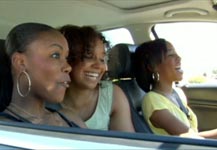 After a serious drought, BET–Black Entertainment Television–has redeemed itself with the creation of the reality series, “Baldwin Hills.” It documents the lives of 11—actually make that ten—upper-middle class African-American teens and 1 middle-class outsider. Does the plot sound familiar to you? It should, because it is a clear copy of MTV’s popular “Laguna Beach” series. But just as the music we listen to is heavily-sample, so shall our so-called original programming be.
After a serious drought, BET–Black Entertainment Television–has redeemed itself with the creation of the reality series, “Baldwin Hills.” It documents the lives of 11—actually make that ten—upper-middle class African-American teens and 1 middle-class outsider. Does the plot sound familiar to you? It should, because it is a clear copy of MTV’s popular “Laguna Beach” series. But just as the music we listen to is heavily-sample, so shall our so-called original programming be.
Parental accountability aside, the regular antics of privileged teenagers ensue. They spend copious amounts of their parents’ money, talk about how great their lives are–based on their access to that money–and spend equal amounts of time judging the less fortunate, who happens to be a girl named Staci. Staci is the one middle-class girl on the show who doesn’t live in Baldwin Hills. She is from a neighborhood that the rich girls like to call the “J’s.” What are the “J’s?” I am not really sure. But it’s clear that it is an undesirable ‘hood far away from the manicured lawns and beautiful vistas of Baldwin Hills.
To show the stark contrast of their lives, we see both sides go shopping before a big party. While the rich girls shop at luxury boutiques like Christian Audigier for custom-made Ed Hardy t-shirts, Staci takes a trip to Rainbow, a bargain basement for the broke-but-fashionable teenager. As Staci cringes at $20 price tags, the Baldwin Hills girls drop $500 on an outfit without remorse. The differences don’t stop there. You can see the huge gap between Staci and the Baldwin Hills girls in their vernacular and sensibilities.
All in all, I loved “Baldwin Hills.” It provided–what I believe–is a balanced portrayal of what life is like for upper-class and middle-class African Americans, which is something we so rarely see on television outside of the syndicated episodes of “The Fresh Prince of Bel Air” and “The Cosby Show.” This season of “Baldwin Hills” will either bridge the gap between the “haves” and the “have-nots” in the black community, or further widen it. Only time will tell …


